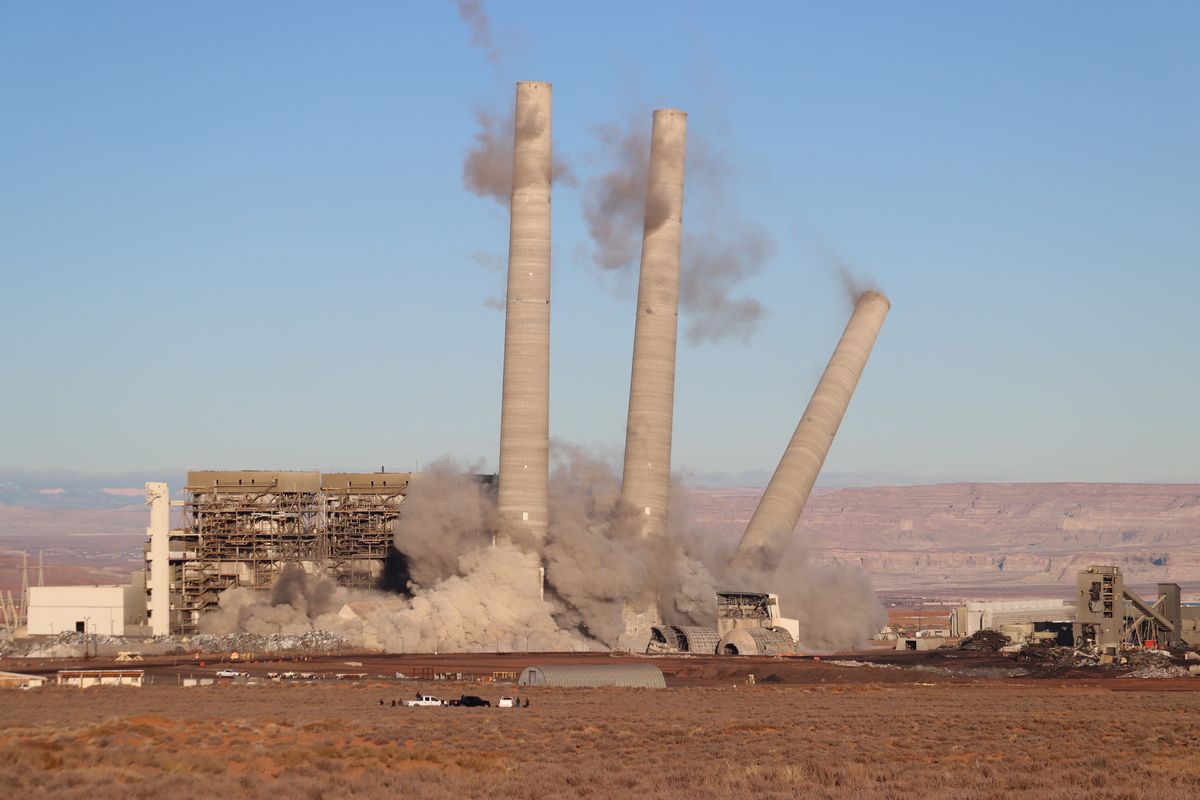11 Dec 2024

Tired Earth
By The Editorial Board

The three 775-foot smokestacks of the 2,250-megawatt Navajo Generating Station (NGS) — the West’s largest coal plant — were demolished December 18, symbolically marking the end of coal’s dominance in a region where renewable energy sources like wind and solar have become far cheaper.
The Salt River Project (SRP), majority owners and operators of NGS, decided to close the plant in 2017 due to rising operating costs. Scott Harelson, a spokesperson for SRP, told me, “Natural gas prices had been low for a long period of time and are much lower than coal. So the plant was out of market, essentially.”
The move to close the coal plant is a part of a broader shift to renewable energy taking place across the US and around the world. According to a report by the International Energy Agency, electricity-generating renewables will have grown roughly 7 percent in 2020, despite the economic fallout from the coronavirus pandemic. This shift has been driven in part by concerns over climate change — but also by increasing questions about the potential health impacts of fossil fuels.
For more than four decades, the station on the Arizona-Utah border had been a critical local employer, providing more than 800 Native people with jobs that paid much higher than the area average. Harelson said 90 percent of the plant’s employees were Navajo.
The station officially shut down in November of 2019 once its remaining supply of coal had burned. The Kayenta mine, which fed the plant, closed in August of 2019 because it didn’t have any other customers besides NGS. Jobs there also paid well: The average salary per worker was $117,000.
But for many members of the region’s Navajo and Hopi tribes, those high wages also came with a high price. Critics of the facility point to its environmental costs as problematic — at one point it released more greenhouse gases at an hourly rate than almost any other facility in the US — and argued it polluted land and water used by Navajo ranchers and farmers.
In a statement Friday, members from organizations representing the Navajo and Hopi tribes welcomed the razing, while acknowledging that the plant brought some financial benefits to their communities.
“The demolition of the smokestacks at NGS is a solemn event,” said Nicole Horseherder, executive director of the Navajo environmental grassroots group Tó Nizhóní Ání. “It’s a reminder of decades of exploitation subsidized by cheap coal and water from the Navajo and Hopi.”
In particular, Horseherder argued that the economic benefits were outweighed by coal miners suffering respiratory ailments and the land being contaminated by polluted water. The statement also said that many Navajo and Hopi had not been able to partake of the electricity and water the plant produced — that most of it went to nearby Phoenix, Arizona.
But now that the station has been demolished, some Navajo and Hopi members have high hopes for a strong future without the coal plant.
Carol Davis, executive director of the Navajo grassroots group Diné CARE, said in the statement, “We’re hopeful that this marks the continuation of our transformation into a sustainable economy that is built on fundamental Navajo and Hopi respect for air, land and water and that will have direct, measurable benefits for our communities, not exploit them.”
A massive cleanup operation has begun
Now that the smokestacks are gone, the land occupied by the facility will be turned over to the Navajo Nation — but first, SRP will be required to complete the complicated and expensive process of clearing the plant’s remaining infrastructure and returning the land to its original state.
“All told, it’s about a $150 million effort to remove all the infrastructure that the Navajo Nation does not want to keep,” Harelson said. “The warehouse, admin building, railroad, lake pump, those facilities, will remain and become property of the Navajo Nation.”
There is also chemical cleanup to do — toxic compounds like coal ash need to be removed. “All of the hazardous chemicals have to be removed and disposed of properly. And there’s an extensive reclamation project to bring the project back to its original state,” Harelson said.
SRP has promised to do this “according to regulations and safety,” but some activists are concerned that there has been too little transparency as to what standards the company is following.
“We need to tell the communities about the toxins that are there,” Diné citizen scientist Kim Smith said. “Just because the smokestacks are going down there’s this mirage that everything is going to be okay, that we’re going to get what we’re owed, that the land is going back to what it was.”
Smith’s comments are a reminder that trust in SRP isn’t universal, as the company has broken promises to the Native community before.
Cassie Scott, for instance, told the Associated Press that her grandmother had allowed part of her land to be used to build the plant in exchange for electricity. However, Scott said, that power never came, and she died without it in 2013.
“The plant generated massive amounts of electricity, yet many homes on the Navajo reservation lacked electricity despite the proximity of the plant,” Michael Hiatt, a staff attorney at environmental law organization Earthjustice, told me. In 2019, NPR estimated that 10 percent of people in the Navajo reservation live without electricity.
Activists have said they plan to carefully watch the restoration process.
“If the utilities don’t follow the letter of the law and don’t clean up or remediate, we’ll make sure that we do bring whatever legal challenges or pressure necessary to make sure it is cleaned up,” Hiatt said.
The plant’s cleanup is scheduled to be completed by 2023 — and the mine will need reclamation as well. That work could employ several hundred of those no longer working in energy generation, according to the Western Organization of Resource Councils, an environmental advocacy group, but has yet to begin.
Source : www.vox.com
Comment